MohammadAli Shaeri
Machine-Learning-Powered Neural Interfaces for Smart Prosthetics and Diagnostics
May 05, 2025Abstract:Advanced neural interfaces are transforming applications ranging from neuroscience research to diagnostic tools (for mental state recognition, tremor and seizure detection) as well as prosthetic devices (for motor and communication recovery). By integrating complex functions into miniaturized neural devices, these systems unlock significant opportunities for personalized assistive technologies and adaptive therapeutic interventions. Leveraging high-density neural recordings, on-site signal processing, and machine learning (ML), these interfaces extract critical features, identify disease neuro-markers, and enable accurate, low-latency neural decoding. This integration facilitates real-time interpretation of neural signals, adaptive modulation of brain activity, and efficient control of assistive devices. Moreover, the synergy between neural interfaces and ML has paved the way for self-sufficient, ubiquitous platforms capable of operating in diverse environments with minimal hardware costs and external dependencies. In this work, we review recent advancements in AI-driven decoding algorithms and energy-efficient System-on-Chip (SoC) platforms for next-generation miniaturized neural devices. These innovations highlight the potential for developing intelligent neural interfaces, addressing critical challenges in scalability, reliability, interpretability, and user adaptability.
Hardware-Efficient EMG Decoding for Next-Generation Hand Prostheses
May 31, 2024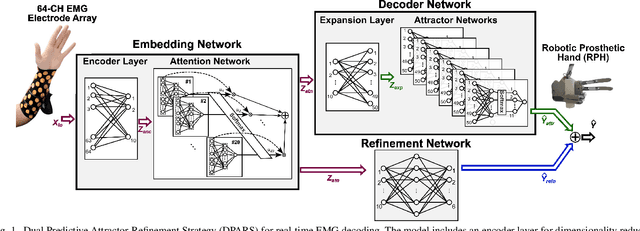
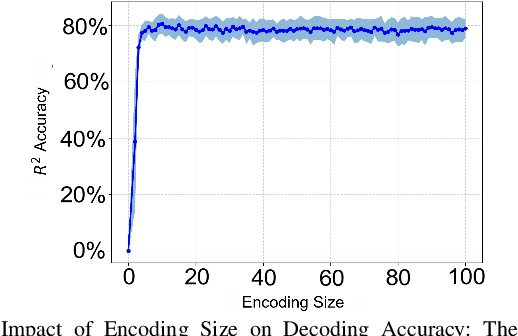
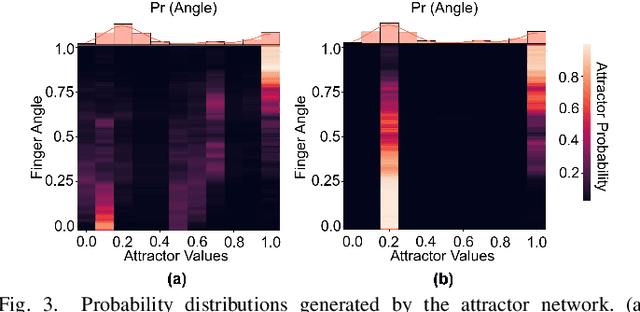
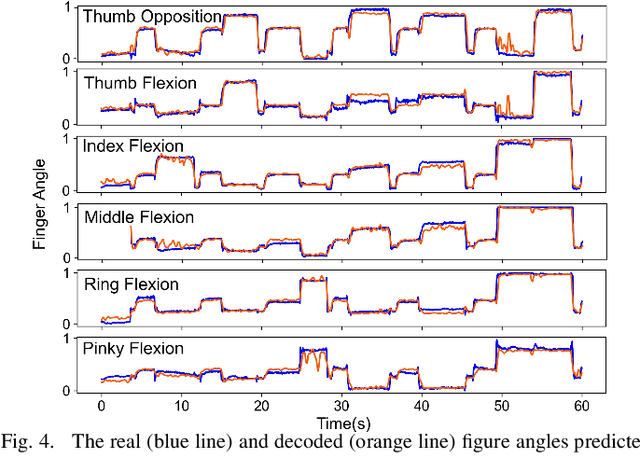
Abstract:Advancements in neural engineering have enabled the development of Robotic Prosthetic Hands (RPHs) aimed at restoring hand functionality. Current commercial RPHs offer limited control through basic on/off commands. Recent progresses in machine learning enable finger movement decoding with higher degrees of freedom, yet the high computational complexity of such models limits their application in portable devices. Future RPH designs must balance portability, low power consumption, and high decoding accuracy to be practical for individuals with disabilities. To this end, we introduce a novel attractor-based neural network to realize on-chip movement decoding for next-generation portable RPHs. The proposed architecture comprises an encoder, an attention layer, an attractor network, and a refinement regressor. We tested our model on four healthy subjects and achieved a decoding accuracy of 80.3%. Our proposed model is over 120 and 50 times more compact compared to state-of-the-art LSTM and CNN models, respectively, with comparable (or superior) decoding accuracy. Therefore, it exhibits minimal hardware complexity and can be effectively integrated as a System-on-Chip.
Intelligent Neural Interfaces: An Emerging Era in Neurotechnology
May 13, 2024Abstract:Integrating smart algorithms on neural devices presents significant opportunities for various brain disorders. In this paper, we review the latest advancements in the development of three categories of intelligent neural prostheses featuring embedded signal processing on the implantable or wearable device. These include: 1) Neural interfaces for closed-loop symptom tracking and responsive stimulation; 2) Neural interfaces for emerging network-related conditions, such as psychiatric disorders; and 3) Intelligent BMI SoCs for movement recovery following paralysis.
An Accurate and Hardware-Efficient Dual Spike Detector for Implantable Neural Interfaces
Aug 29, 2022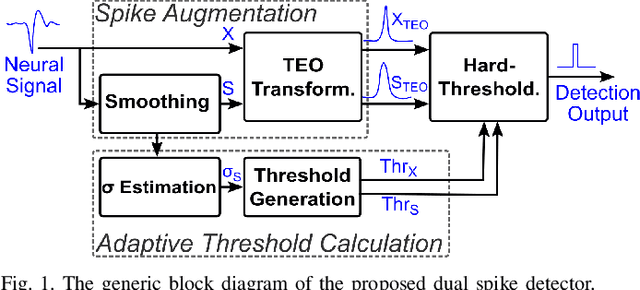
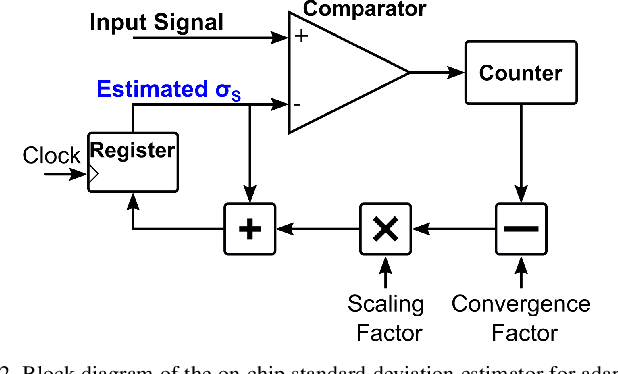
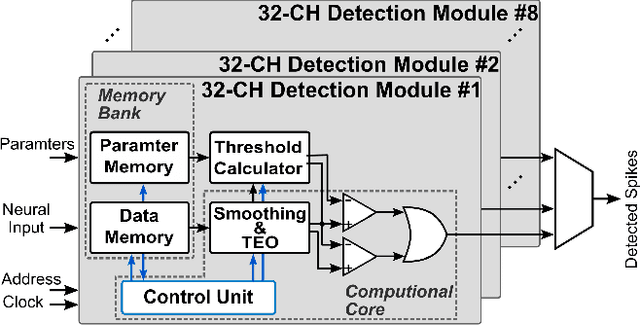
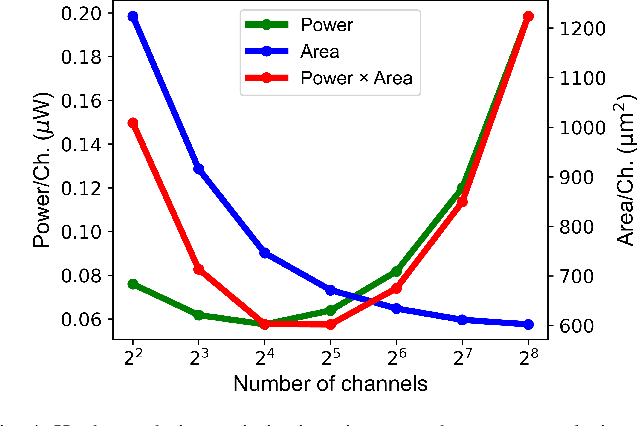
Abstract:Spike detection plays a central role in neural data processing and brain-machine interfaces (BMIs). A challenge for future-generation implantable BMIs is to build a spike detector that features both low hardware cost and high performance. In this work, we propose a novel hardware-efficient and high-performance spike detector for implantable BMIs. The proposed design is based on a dual-detector architecture with adaptive threshold estimation. The dual-detector comprises two separate TEO-based detectors that distinguish a spike occurrence based on its discriminating features in both high and low noise scenarios. We evaluated the proposed spike detection algorithm on the Wave Clus dataset. It achieved an average detection accuracy of 98.9%, and over 95% in high-noise scenarios, ensuring the reliability of our method. When realized in hardware with a sampling rate of 16kHz and 7-bits resolution, the detection accuracy is 97.4%. Designed in 65nm TSMC process, a 256-channel detector based on this architecture occupies only 682$\mu m^2$ /Channel and consumes 0.07$\mu$W/Channel, improving over the state-of-the-art spike detectors by 39.7% in power consumption and 78.8% in area, while maintaining a high accuracy.
Challenges and Opportunities of Edge AI for Next-Generation Implantable BMIs
Apr 13, 2022
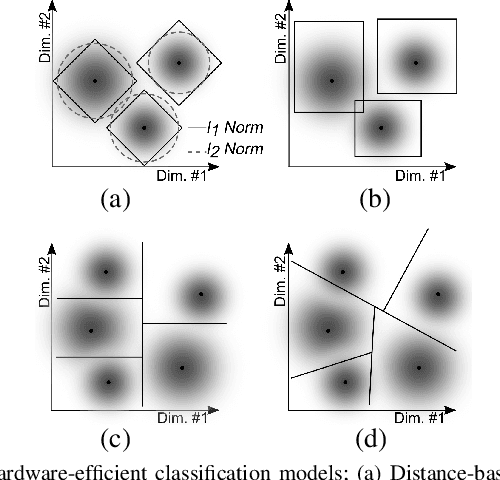
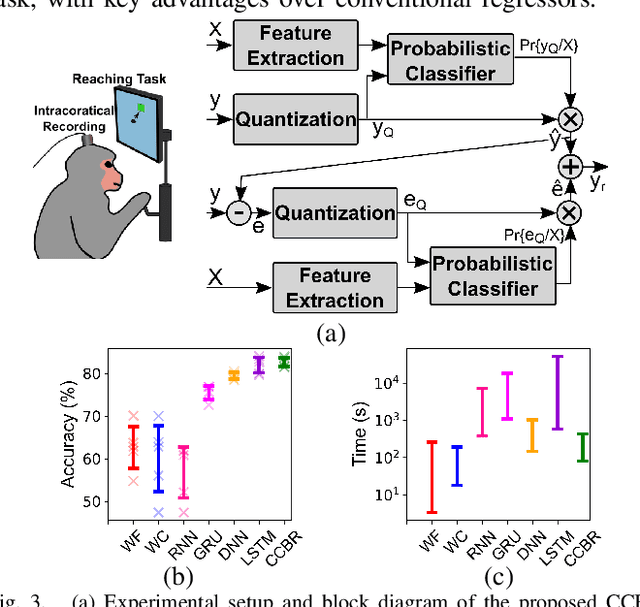
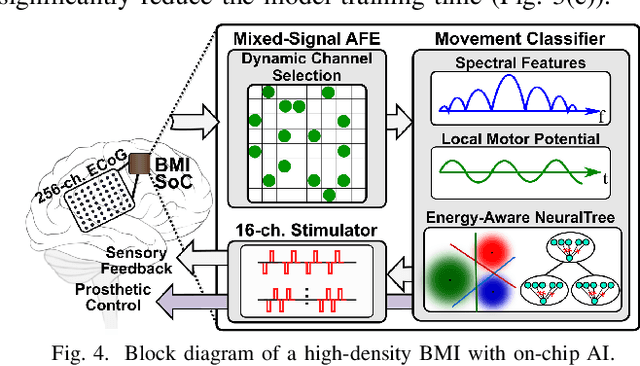
Abstract:Neuroscience and neurotechnology are currently being revolutionized by artificial intelligence (AI) and machine learning. AI is widely used to study and interpret neural signals (analytical applications), assist people with disabilities (prosthetic applications), and treat underlying neurological symptoms (therapeutic applications). In this brief, we will review the emerging opportunities of on-chip AI for the next-generation implantable brain-machine interfaces (BMIs), with a focus on state-of-the-art prosthetic BMIs. Major technological challenges for the effectiveness of AI models will be discussed. Finally, we will present algorithmic and IC design solutions to enable a new generation of AI-enhanced and high-channel-count BMIs.
 Add to Chrome
Add to Chrome Add to Firefox
Add to Firefox Add to Edge
Add to Edge